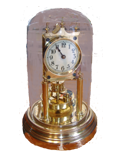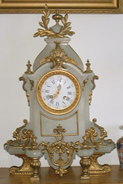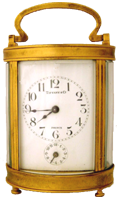Clock Repairs
To identify some common clocks, here you can see some examples of the clocks
we repair
but this is by no means a complete list
The costs for repairs will vary, but
No VAT will be added
If you are sending any clock by post, please contact me first and also view my
how to pack a clock instruction page.
 ATMOS Clock
ATMOS Clock
We specialize in the repair of Atmos clocks
-- Clockmaking at its best --
Atmos clocks are made by the renowned swiss company Jaeger LeCoultre.
This is a very fascinating mechanical clock that does not require winding.
ATMOS clocks have a "bellow" that expands and contracts with temperature changes or atmospheric pressure changes. These small movements are utilised to keep the mechanism running.
Even though the Atmos is a very fine clock, it does require to be serviced to keep it running, just like any other clock. If the clock is giving trouble, It may not necessarily due to broken or worn parts.
Other information that may be of interest to you,
please follow the relative links
ANTIQUE LONGCASE Clocks
This is the typical english clock of the haydays of the english clockmaking industry.
Domestic "grandfather" clocks can date from the 17thCent up to the late victorian period,
any later than that and they are usually defined as "reproductions".
Most of these clocks have either 8day or 30hour movements.
They can be distinguished because the 8day is wound with a key and have 2 weights,
while the 30hours is wound manually by
pulling up a single weight inside the case.
Owning a clock like this, at the time, was like a "status symbol" and
only the rich could afford the 8day model.
The super-rich also owned another
smaller clock, a DIAL CLOCK, so that the servants could tell the time to regulate their duties.
30hour movements are more common, as they were more affordable
MODERN
GRANDFATHER Clocks
from circa 1900 to modern days
There are many variation of the casse design
They usually have a german movement of reasonable quality .. or less common, a high quality american movement.
The modern version of the "grandfather clock" is easily identified by these characteristics:
1) The weights are thin and relatively light, usually 3 of them, encased in brass shells. Antique clocks have one or two weights only.
2) The dial is quite thin and flexible.
3) The pendulum bob, whether large or small, is hollow and light.
 400day or ANNIVERSARY Clock
400day or ANNIVERSARY Clock
These clocks started being produced from the end of the last century and
they have always been very popular, being meant to remind the
owner of a special event in their life. They are wound once a
year, on the day of the celebrated event, marriage, retirement,
etc.
they come in various sizes and the pendulum has various designs,
depending from the age of the clock.
Usually, these clocks were not meant to be horological masterpieces,
the quality of production can be rather poor, and some, I would
go as far as saying, that they were just "prototypes", that is
why until recently some clockmakers
avoided repairing them.
They have a definite place in the history of clocks and that is why,
in recent years, there has been a resurgence of interest in these clocks from
collectors
Carriage Clocks
These clocks, date as far back as the early 1800's. Its invention is attributed to the famous french clockmaker Abraham Louis Breguet. They were particular popular because of their ease of transportation and compact size; certainly very useful to army officers that had to pack and travel quite often. Their quality and features have enourmous variation, from the very simple timepiece to Stk / Reapeters and up to Grand-Sonnerie and Minute-Repeaters with day, date, alarm, etc, functions
click here for more information about Carriage Clocks
 French Pendulum Clocks
French Pendulum Clocks
They come in all different cases from marble to wood, from Ormolu
to table regulators etc etc, and can date as far back as the 18th
Cent
Follow the link for identification points.
In my modest opinion, they are the best ever "mass produced" clocks.
Their quality is far superior to many non-mass-produced clocks.
They have lasted for many years and many will be around for many
years to come. For years they have been undervalued due to the
incredible number produced and they have been incredible value
for money. Many famous names are associated with french clocks,
and even top clockmaker have not been ashmamed to put their names
on these clock as an assurance of quality,... Brocot, Drucot,
Dent, Mappin & Webb
etc just to name a few.
 Dial Clocks
Dial Clocks
The "fusee" model first appeared in the early 1800s and were very popular
throughout this century and the early 1900s. They were everywhere,
in all public buildings, train stations, banks, offices etc. If
you consider that they all needed winding weekly, repairing, dials
repainted etc. they must have provided work for thousands of people.
The "fusee", the cone shaped mechanical gear typical of these clocks, is
designed to deliver timekeeping accuracy by
evening out the strength of the mainspring throughout the whole week.
Later on, as the mainsprings'
metallurgical properties improved, the fusee disappeared. Also,
american and german models were imported for the British market.
Most dial clocks have pendulums but there are also models with platforms
( i.e they have a balance, no pendulum)
 Ship's Clocks
Ship's Clocks
As the name implies many of these clocks came from ships, submarines, etc. and can go far back as the 19th Cent.
There are great variations in construction: Earlier ones have "fusee movements", some are timepieces, some strike the ship's bells but all have platform movements (i.e. have a balance, not a pendulum).
Typical cost of repair can vary enourmously according to model and condition and it is best to get an estimate
THIS IS NOT THE COMPLETE LIST OF ALL THE CLOCKS THAT WE REPAIR, PLEASE ENQUIRE


